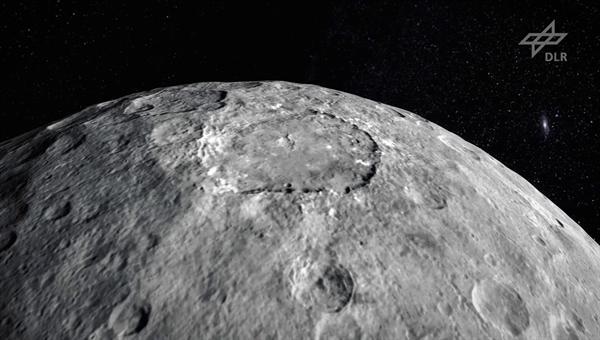Flight over dwarf planet Ceres

Your consent to the storage of data ('cookies') is required for the playback of this video on Quickchannel.com. You can view and change your current data storage settings at any time under privacy.
NASA/JPL-Caltech/UCLA/MPS/DLR/IDA
The Dawn orbiter initially traced the path of the equator before crossing the north and south poles of Ceres. Researchers at the German Aerospace Center (Deutsches Zentrum für Luft- und Raumfahrt; DLR) have used the images acquired thus far with the Framing Camera on board the spacecraft and the first three-dimensional terrain models created from them to produce a virtual scenic flight over icy Ceres. "Never before have we seen all of Ceres in three dimensions," says DLR planetary researcher Ralf Jaumann, who is involved in NASA's Dawn mission. The virtual flight – at over 335 million kilometres from Earth – sweeps across crater landscapes, lighter areas and vast plains.
To get a glimpse of what Ceres would look like if one were on the orbiter itself, scientists from the DLR Institute of Planetary Research processed a total of 80 images – some acquired from an orbit altitude of 13,500 kilometres and others taken for navigation purposes at distances of 7000 and 5100 kilometres. "Here, we used a three-dimensional terrain model that we had produced based on the images acquired so far," explains Jaumann. "They will become increasingly detailed as the mission progresses – with each additional orbit bringing us closer to the surface." The DLR planetary researchers are also responsible for producing cartographic surveys of the dwarf planet.
'Dry' Vesta and 'wet' Ceres
The dwarf planet has already proven its worth as an interesting object for scientific study. "Looking down on Ceres from space, we see a variety of geological formations that show how powerful forces have shaped the surface of Ceres." The researchers had to wait seven years for the Dawn spacecraft to reach the asteroid belt between Mars and Jupiter; this happened on 6 March 2015. When the orbiter was launched – on 27 September 2007 – Ceres was still classified as an asteroid. Now, it has been 'promoted' to the category of dwarf planet. En route to its destination, Dawn paid a visit to asteroid Vesta, which it orbited from July 2011 to September 2012 – acquiring tens of thousands of images.
The connection between these two celestial bodies is that they are among the largest found in the asteroid belt. Vesta has a diameter of 530 kilometres, and Ceres is larger, at almost 1000 kilometres across. In spite of this, they are extremely different; Vesta is what is known as a 'dry' asteroid that did not absorb much water during its formation. In contrast, Ceres is located further from the Sun and could even have an ocean beneath its icy crust.
The mission
The Dawn mission is managed by NASA's Jet Propulsion Laboratory (JPL) in Pasadena, which is a division of the California Institute of Technology, for NASA's Science Mission Directorate in Washington DC. The University of California, Los Angeles, is responsible for overall Dawn mission science. The camera system on the spacecraft was developed and built under the leadership of the Max Planck Institute for Solar System Research in Katlenburg-Lindau, Germany, with significant contributions from the German Aerospace Center (DLR) Institute of Planetary Research in Berlin and the Institute of Computer and Communication Network Engineering in Braunschweig. The Framing Camera project is funded by the Max Planck Society, DLR, and NASA/JPL.
